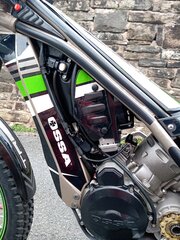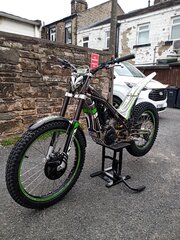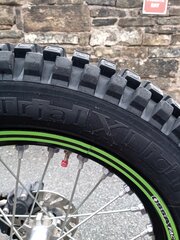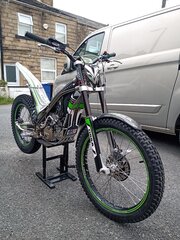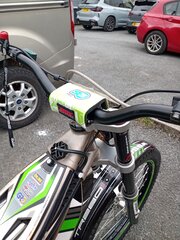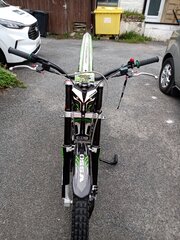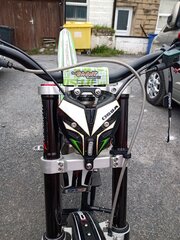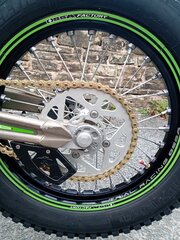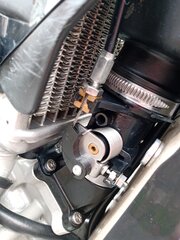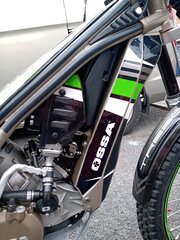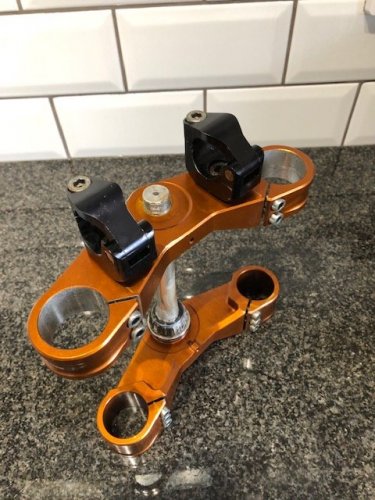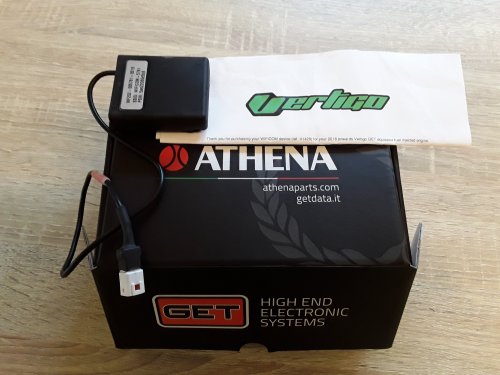All Activity
- Past hour
-
Hey Tybone, would you be willing to post a photo or two of your TY? I’d love to see it!
-
Dan, I can add some detail about variable-reluctance pickups. The one shown here is from a Chinese pitbike, but it's representative of what's commonly used. The coil has a DC resistance of 145 ohms. Inductance is 63mH in air. Inductance is 61 mH when contacting steel. (Both measured at 1 kHz.) The magnet has its North pole facing out. The oscilloscope capture shows the waveform when a block of steel is repeatedly brought into contact with the pickup magnet and withdrawn (by hand). Each positive pulse is contact, each negative pulse is the withdrawal. The waveform is asymmetric because the rate of change in the magnetic flux is faster when making contact (magnet pulls on the steel) than when moving the steel away.
- Today
-
The spark plug operates off of a pulse generated when a triac trigger dumps the stored charge from a capacitor through the primary side of the ignition coil. Hence the term Capacitor Discharge Ignition. The voltage used to charge that cap is rectified by high voltage diodes in the CDI unit. The timing curve is programmed into a microcontroller in the CDI.module. These are typically run on 5V which will be derived from the 14.9V signal out of the rectifier. So the high voltage side of the CDI that fires the spark plug is isolated from the low voltage side of the CDI.that controls the trigger sense and the firing of the triac. This can be done in several ways but the cheapest and easiest is a transformer. The secondary side of the ignition coil is its own circuit which has to have a complete path back to the common of the ignition coil. As I said in older engines the engine case usually had a hard ground connection. The EVO doesn't and relies on the ground wire at the back of the frame through the engine cases to the cylinder. In my bike with titanium screws and magnesium cases that connection may not be as "hard" as necessary for the spark current. High rise time signals don't always behave the same as dc As for the diagram it's straight from the Beta manual with things not on my bike removed and annotated with my measurements. If your buddy crushed a capacitor on his bike he must be a European spec bike as the cap is used to smooth out the voltage for the lighting system. The US spec bikes don't have that cap. From a purely mechanical perspective what the diagram shows as three stator coils is actually 10 coils for lighting which are probably connected in parallel to supply low voltage high current and two coils for the CDI charge voltage which are likely wired in series to provide the high voltage needed to charge the capacitor in the CDI. The third coil shown on the schematic is the reluctance sensor that triggers the CDI. The face of the trigger sensor looks like it has had contact but I think this is just how it was adjusted at the ignition manufacturer since there are no witness marks on the flywheel to indicate contact. I suspect the construction of the sensor isn't just a magnet and coil but includes a pole piece that allows some flexibility in manufacturing as the pole piece can be ground down to proper clearance after the sensor is encapsulated. If you tried to do that with a rare earth magnet it would shatter. They are notoriously brittle. I plan to get a much better look at all the signals once I have a breakout board and can sniff them while the bike is running. I have several oscilloscopes here but I'll not risk the benchtop equipment playing with unknown voltages. That's why I bought some "sacrificial" cheapo portable scopes. But for now the bike is running as it did without sending the stator for a rewind. Or a $300 replacement. And I learned some stuff. So win-win. I'm just trying to share my learning with my EVO peeps who might not have the experience in electronics I have. I'd love to tear into the CDI module but that would be an expensive exploration. So for now it remains the classic electrical engineering "Black Box Problem" where you can see the goesintas and goesoutas but what happens in the box can only be guessed at.
-
If you have big calves, the Gaerne Balance Classic is a great choice — users with around 20" calves said the velcro just about closes. The Forma Boulder also offers extra room and better comfort around the calf. Avoid brands like Alpinestars or Sidi, as their boots tend to be narrower. Look for models with adjustable buckles and long velcro straps for flexibility. Always check the boot’s calf measurement before buying online. Trying them on with your riding trousers can help ensure a good fit. In short, Gaerne and Forma are the top options for riders with larger calves.
-
paradoxlondon joined the community
-
Want the scary news, one way for those parts to collide is the result of excess play in the crankshaft bearings. Grab the crank firmly and see if you can detect any play in the crankshaft bearings or in the taper shaft and and inspect the keyway on the armature to eliminate that as being a problem.
-
Just a few observations and suggestions; 1) your spark plug does not require or use rectified voltage to operate, AC works just fine to produce a spark. 2) that pickup coil needs to be cleaned and the proximity between the pickup and the spinning magnet needs to be as small as possible without ever physically touching. That is likely how you 'fixed' the bike when you removed and reinstalled it. None of those magnet to coil surface interfaces should include rust or metallic debris. 3) the head bolts should provide a solid sparkplug ground. 4) your diagram shows an ignition system with 2 coils, one coil dedicated to spark and the other to 12volt accessories such as LED lights and fan motor. Your photo appear to show a multi phase stator coil 🤔 you might not have the correct wiring diagram or the schematic displays the stator coils in a curious fashion. ... if the bike runs and you want to test the alternator outputs, best is to use an oscilloscope. add: my riding partner crushed a small capacitor that is wired up near the headlight and steering stops crushed it. You might want to check that part assuming his EVO is the same as your EVO add: the black box module almost certainly adjusts spark advance timing and that is likely where the biggest difference is between the various modules. ... timing of the spark is almost the only thing that can be adjusted.
-
I also ride mountain bike ( EMTB to be honest ) and when they became avalable I bought a MIPS rated helmet, mabe that's why I'm '' suffering '' so much with my trials helmet to the point that I'm looking at a new one with more ventilation.
-
Hmmm looking at closeups of the other connector and I noticed the water seal on the back of the high voltage wire (Red/White) to the coil looks less than perfect.
- Yesterday
-
Is a bicycle helmet as safe as a motorcycle helmet? Probably not. But modern MIPS-rated helmets are pretty good. See: https://www.helmet.beam.vt.edu/bicycle-helmet-ratings.html It may partly depend on the ambient temperate at which you ride. I know that if my brain gets overheated I don't make good decisions, and am more likely to actually need a helmet. Assumption of personal risk is a very personal decision.
-
I’m not sure I agree with an MTB helmet so I’m putting this out there for consideration. There’s an old saying that goes like this, “Buy the best helmet you can afford!”. The reason being is that you’re playing Russian roulette with your brain. MTB helmets aren’t subject to the same testing standards as DOT helmets are. Yes, trials riding isn’t as fast as street or MX but what happens if you go down and the bike lands on your head that’s next to a tree, rock or hard pack. The shells on MTB helmets aren’t as strong as a rated helmet because MTB bikes weigh a fraction of what a motorcycle weighs.
-
Back with learndings about the electrical system on my EVO after it glitched and cracked some ribs. Thought it was carb but seems it was electric. One interesting insight was how the electrical system finds ground for the spark plug. The other was the revelation that the 300 Ohms called out in the owners manual for the trigger coil might be a wrong value so if you're diagnosing your Stator and the trigger reads 185 Ohms you're probably OK. EDIT, fixed some typos Beta debug.pdf
-
Probably the best-ventilated helmets are for mountain biking (MTB). Might be worth a look if your club does not require a motorcycle-specific helmet. Probably easier to find a vendor to try something on as well. My wife wears a full-face MTB helmet all season for trials.
-
I agree with you Konrad, I need to try it on before buying, the problem I have here in Quebec, is there is not a lot off trials gear retailer and they are quite far apart, so any info will probably save me a lot of traveling.
-
If there is any way for you to try on a prospective helmet before buying, I strongly suggest you do so. I bought a GasGas-branded Hebo Z4 Carbotech by mail because it was a fabulous price. The Carbotech is a top-of-the-line helmet with two annoying (to me) "features". 1. The cheek pads were far too tight, despite the helmet otherwise fitting perfectly. I figured they would eventually "pack out", but did not. I ended up removing them completely. 2. The buckle hit my Adam's apple, which was most uncomfortable. I eventually improved that somewhat, but it's far from perfect.
-
-
Flash1 started following IMG_20250809_133435_358.jpg , IMG_20250809_133456_449.jpg , IMG_20250809_133410_483.jpg and 7 others
-
Recent Topics
-
Classifieds
-
TC News Feed






